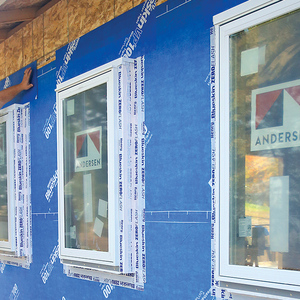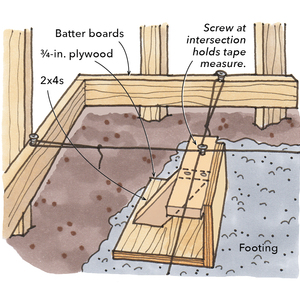I am planning on turning my “garage” into a family room. What is the general consensus as far as insulating and framing for the floor? I was thinking of framing with 2×8’s on edge, with either blue rigid foam between the joists, or kraft paper insulation of a decent r-value. We talked on the job today about the value of using plastic sheeting under the whole deal, but we’re a little concerned with creating a double vapor barrier and having mold growth. Also wondering if you can use ACQ inside a living space? Hmm… So many options. Really want to do this right! Doug
Discussion Forum
Discussion Forum
Up Next
Video Shorts
Featured Story

The Titan Impact X 440 offers great coverage with minimal overspray.
Featured Video
Video: Build a Fireplace, Brick by BrickHighlights
"I have learned so much thanks to the searchable articles on the FHB website. I can confidently say that I expect to be a life-long subscriber." - M.K.
Fine Homebuilding Magazine
- Home Group
- Antique Trader
- Arts & Crafts Homes
- Bank Note Reporter
- Cabin Life
- Cuisine at Home
- Fine Gardening
- Fine Woodworking
- Green Building Advisor
- Garden Gate
- Horticulture
- Keep Craft Alive
- Log Home Living
- Military Trader/Vehicles
- Numismatic News
- Numismaster
- Old Cars Weekly
- Old House Journal
- Period Homes
- Popular Woodworking
- Script
- ShopNotes
- Sports Collectors Digest
- Threads
- Timber Home Living
- Traditional Building
- Woodsmith
- World Coin News
- Writer's Digest


















Replies
First step: take a piece of clear poly sheeting about 2' (or more) square and tape it down to the concrete. If there is moisture coming up through the slab, it will condense on the underside of the plastic. That will give you an idea of what you are dealing with moisture wise.
Sag Harbor, New York. Out on the east end of Long Island. Usually mild winters, except this year! Hot in June and July and the rest is fairly mild.
Get a copy of FWW's TOOLS & SHOPS (annual issue) Winter 2002, No. 160
Turn to page 60, and read the article titled: Low Cost Shop Floor.
Basically, the article suggests using treated 2x4 sleepers fastened to the concrete floor, with 1-1/2 inch ridgid foam insulation laid between the sleepers. The author then installed 6 mil poly over the insul before putting down 3/4 inch T&G plywood sheathing for the floor.
I have done 3 floors this way except I never installed the poly, just sleepers and foam. Floors are approx 8 - 10 years old now and still in very good shape today.
My question to you is why you would want to use 2X8s, unless you are considering ductwork to be installed underneath? Raising a floor that high will result in a drastic change to all existing door height elevations.
If your winters are as mild as you say, I think that your planned 7-1/4 inch floor thickness packed full of insul is a waste of money. If you are planning to add carpeting, coupled with nominal insul,your floor should be plenty warm.
Just my 2 cents.
Davo
Well thanks Davo! I appreciate your time and advice. The reason for the 2x8's is that I need to bring the floor level up to get over a step that is coming down from my kitchen and to also meet the level of an entry door to my deck. The space was set up as a garage but never used as such. I am wondering if I can use ACQ indoors? I know the building dept. didn't allow CCA to be inside... My termite inspector suggested using treated lumber because the chemicals used these days are not strong enough to last very long. (He has treated under the slab floor in the past by drilling holes etc.) The blue foam sounds good to me too. Thanks again. Doug
Doug,
Since you need to use 2x8s, and since you've expressed a termite concern, you should discuss this situation more thoroughly with a termite expert.
For starters, not all ridgid foams are termite proof...infact, termites love to burrow in some types. I think Dow's blue foam is one that is termite resistant, but not really sure on this fact. The cheapest way to insulate a 2x8 cavity, and be termite resistant is with the use of blown-in cellulose insulation. This would be very easy to do...frame in your joists, then insulate, then install subfloor overtop.
Again, it would be best to consult a termite expert on what insualtion types are best defense against termite infestation.
At the very least, I would use a urethane based sealant ( such as NP-1 mfg by Sonneborn Chemrex) around the perimeter of the floor/wall juncture I also would use this to fill up any other visible floor cracks.
An old method to help stop moisture from rising up through the slab was to trowel down a thin layer of roofing tar overtop the concrete. You mention that you may not be permitted to use treated lumber for your floor framing. With this in mind, I think that perhaps in your situation I would do the following:
1. Install urethane sealant around wall/floor juncture throughout.
2. Lay down thin coat of asphalt tar (roofing tar) and cover over ( embed) with 30# tar (roofing felt) paper.
3. Install regualr 2x8s overtop of felt paper.
4. Blow in cellulose insulation in all joist cavities to top of joist.
5. Install 3/4 inch T&G sheathing onto joists.
Just a thought.
Davo
Interesting interpretation of not using treated lumber on the inside of the house. KY residential code stipulates any framing lumber ( in his case the 2x8s) in contact with masonary or the ground shall be treated.
If you think in terms of an unfinished basement, the mud sills are treated lumber and exposed on the inside of a home.
Finishing the basement would cover or incapsulate the treated material. This would be similar to what he is doing. The 3/4" t&g subfloor would incapsulate any treated lumber used for the framing.
It would be less labor intense and possibly cheaper in total material cost to use treated lumber in this case. Still needs to be run by the inspector or local code authority befor starting the job. I quick phone call would answer the question.
I would not be to concerned about termites penetrating the slab and burrowing in the foambaord. The present treatment sould be sufficient if the slab was drilled and the chemicals pumped into the ground at the slab perimeter. Retreatment of an interior slab is a money maker for the exterminator. Unless there is an extremely high water table in under the slab, those chemicals don't just go away. They are still there. I would concentrated future treatments on the exterior perimeter of the garage and house. Creating a barrier outside is the primary line of defense.
Dave
"Unless there is an extremely high water table in under the slab, those chemicals don't just go away."
Dave,
Actually, most of the east end and southside areas of LI have a VERY high water table. LI (well most of it anyway) is terminal glacial moraine. Basically sand and gravel and such (not everywhere, but many places). In many areas not too far above the ocean, dig down a foot or two and it gets very damp real quick.
Jon
But don't sand and gravel also mean it's very easy to drain?
Like Uncle Dunc, I would think that a sand /gravel mix would drain weel, but you would get wash out of any chemical treatment. Still, I believe an exterior barrier would be a sound defense agianst the boogers.
As an aside, I read an alternative to chemical treatment for termites, you can use a sand barrier. Not sure what area of the country it was reccomended for though.
Termites need a food source, moisture, and very little air to operate. The food source, they forage for, but only in a damp enviroment. That is why they build mud tunnels to get up a wall to those tastey framing members. Subteranian colonys will swarm when it becomes too large, and/or produces a second queen. That is ussually when the HO realizes they have a problem. Then it is a day late and a dollar short..., some damage has already been done. One interesting thing I learned from my late brother (state herbicide/pesticide enforcement inspector) was that termites are basiclly blind foragers. They are not attracted to cellulose, just because it is there. they need to run into it in their search. This is basically true for all subteranian speices, but does not apply to varieties they have in the coastal areas of the south or Hawia. Those buggers run out of food, they take wing and find more! I believe they are some type of Formosa speices that is native to tropical climates, not native to this country.
Has anyone here ever seen termite nesting in foam board? I keep hearing about it, but have never seen it. I have seen ants, and other subteranian bugs burrow into foam board, but never termites.
Dave
"you can use a sand barrier. Not sure what area of the country it was recommended for though."
Dave,
I remember hearing that one too. Pretty sure it was Hawaii.
Jon